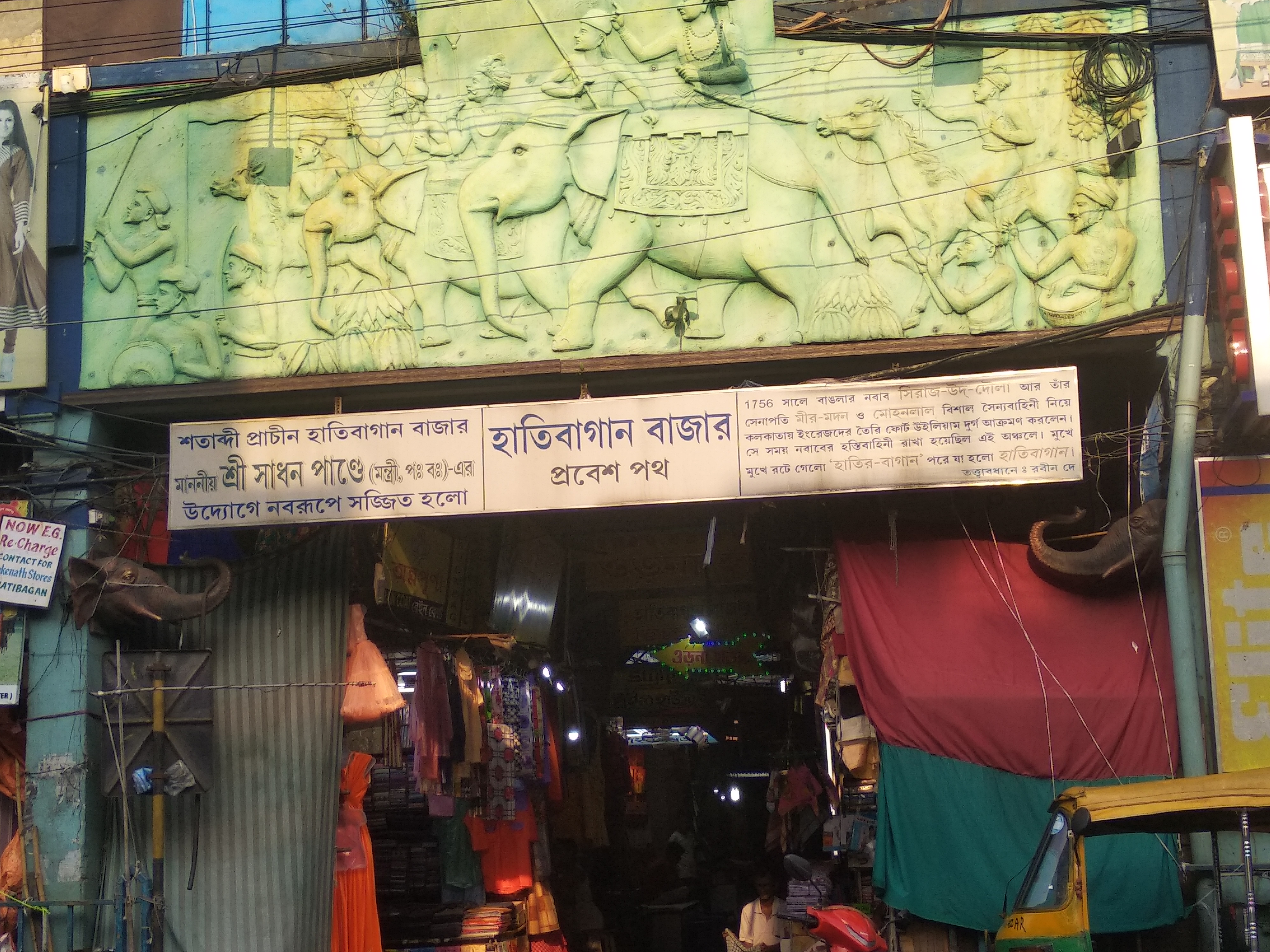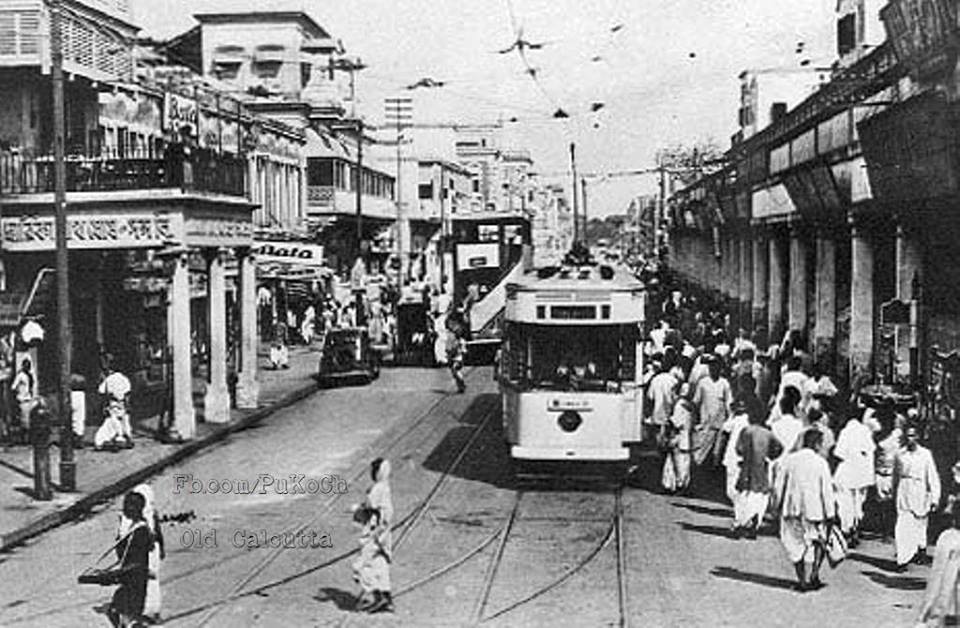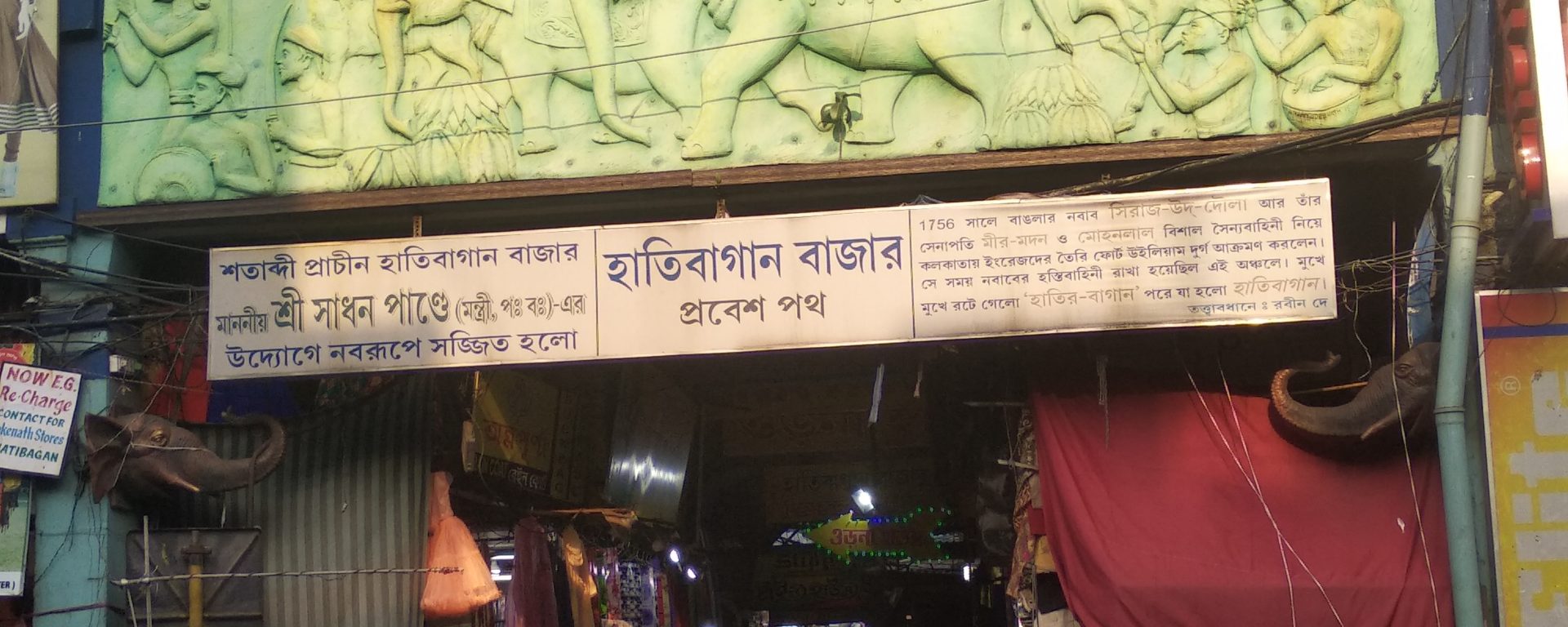Come the post monsoon season, the footfalls still increase in the entire stretch of Bidhan Sarani, erstwhile Cornwallis Street, in search of new saree designs or new dresses. Still now, in many Bengali households, Pujor Bajar start from and end in Hatibagan. Hatibagan still stands in testimony to the bygone time when people flocked in crowds to buy ‘Alpin to Elephant’ here after watching their favourite films shown in the single screen cinema halls, while joining in interesting conversations (read Adda) on their way to their respective homes.

The main gate of Hatibagan Market says that Nawab Siraz-ud-Daula along with his generals Mir Madan and Mohanlal attacked the British constructed Fort William in Kolkata in the year 1757. His elephant troops were stationed in the area presently known as Hatibagan. The name Hatibagan was infact drawn from the reference of elephants’ garden or the place where elephants were kept.

Some other sources however say that the area belonged to an influential person of surname ‘Hati’ and so his property area got the name ‘Hatibagan’. The property was later bought by Mehtab Chand Mullick who established the famous market.
Another interesting source claims that another meaning of the word ‘Hati’ is ‘a help in work’. In ancient Kolkata, the ‘babus’ came in this area in search of ‘helps’ in construction work or for any other household work. Whatever the purpose may be the ‘Hatibagan’ area provided ‘helping hands’ for all seasons. These ‘helping hands’ stayed in the ‘jhupris’ near this area, thus the name.

The erstwhile Hatibagan was nothing short of a tinsel town with single screen cinema halls lying close to each other. Radha, Rupabani, Sree, Uttara, Minar, Darpana, Mitra and Talkie Show House represented a world of fantasy. Alas! Among them only Minar and Talkie Show House have managed to stand against the rapid gulping down of single screen halls by the multiplexes. The Star Theatre, presently transformed into sort of a multiplex, was a mecca of theatre where noted thespians like Noti Binodini, Girish Chandra Ghosh, Shishir Bhaduri, Shambhu Mitra and the likes produced and acted in legendary Bengali plays.


The cultural environment of Hatibagan also thrived due to the presence of exquisite Bengali ‘Taant er Saari’ and ‘Silk Sarees’. The ready to wear clothes as well as dress materials of finest quality in cheap possible prices was and are still available in the age-old shops. Although, most of these shops had got transformed into shopping malls which are again eating into the profits the shopkeepers made previously. The famous readymade shops of ‘KL Dutta’ and the saree shop of ‘Surya Bastralay’ yielded place to the present V-Mall and similar other cousins.
Most probably the only part which have remained undeterred by the invasions by the bigger commercial brands is the flea market present on the footpaths of the entire stretch of the Hatibagan Market. The modern fashionistas can still be seen buying matching accessories with the dresses they had bought from the so-called big malls. Why do they return here? Most of them say ‘Ekhaner moto kothao pabo na’ (We won’t get similar qualities in cheap prices from anywhere else).

Not only for dresses, accessories and cinema halls, the Hatibagan area is also famous for the variety of street food it offers. On any day and every day, the hungry crowd in front of ‘Adi Malancha’ and the ‘Chhola-Bhatura’ seller can defeat the cumulative crowd of ‘Wow Momo’, ‘Pizza Hut’ and ‘KFC’ just lying on the other side of the ‘Bidhan Sarani’. Almost all the fuchkawalas of Hatibagan delivers tasty Fuchkas. They probably compete with each other on the taste factor, they should be, because the ‘Fuchka connoiseurs’ flocking this part of Kolkata knows their ‘Fuchkas’ really, really well.
The Hatibagan area has a ‘World War II’ connection as well. During the bombings by the Japanese troops over Kolkata, one of the shells got dropped in the Hatibagan area. The shell did not explode and its remnant can be still seen buried into the ground just near the present SBI branch building near Hatibagan crossing. The SBI Branch building is also famous or infamous in another way. Revolutionary Sri Aurobindo Ghose was arrested from that very house as a convict in the ‘Alipore Bomb Case’ by the British Police.

Though much have lost in the ravages of time, historically and culturally, the heritage of Hatibagan is there for us to mesmerise ourselves in and continue to retell them to our new generations to come.
Information Source:
- Purono Kolkatar Golpo, Facebook group
- www.getbengal.com
- Senior residents living in the area
Content Curated by: Kolkata Fusion


Khub sundor laglo
Thank you!!